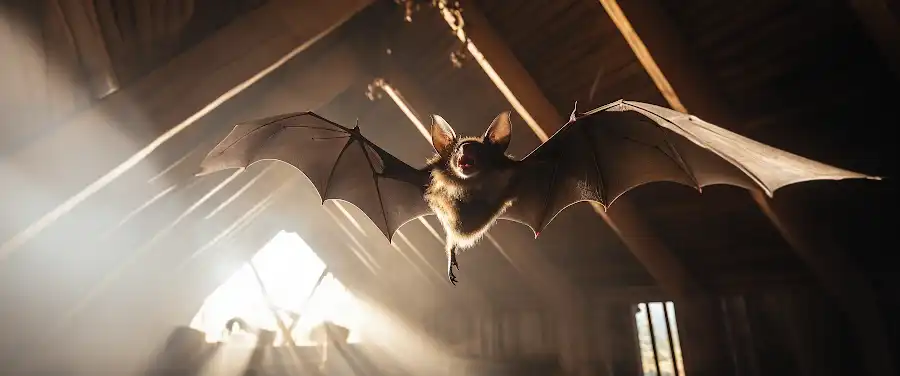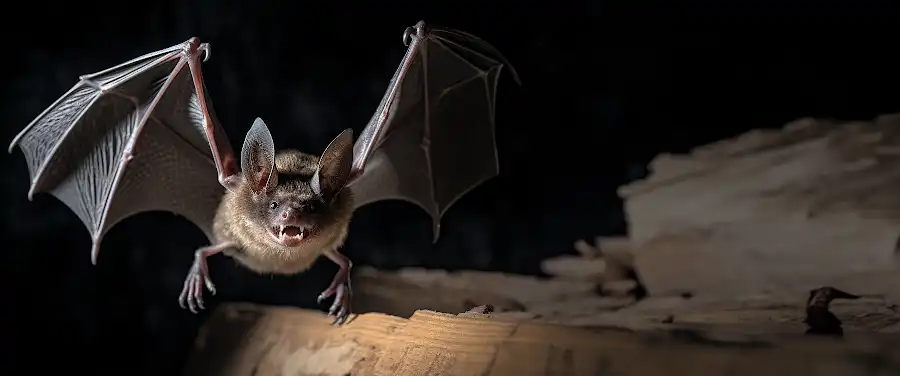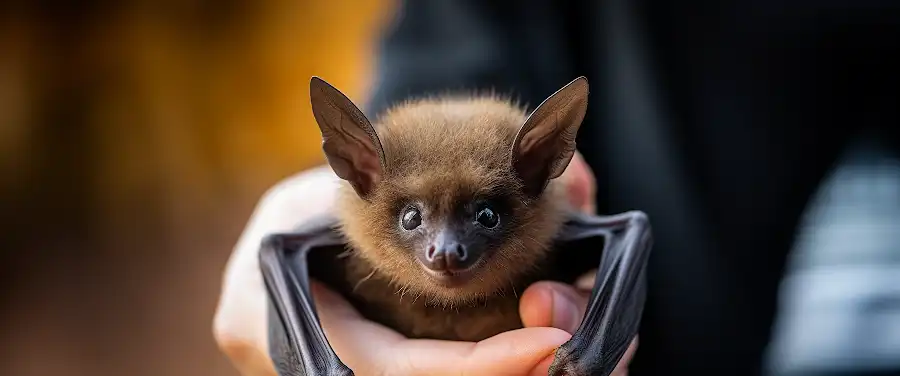
As we stride forward in our urban lives, it’s easy to forget that we share our world with a multitude of fascinating wildlife, each with a crucial role in maintaining our ecosystem’s balance. One such creature is the often misunderstood, rarely appreciated bat. Many of us, whether due to ominous folklore or simple unfamiliarity, may view a bat intrusion in our homes as an unwelcome nightmare. However, it’s important to remember that these flighty night dwellers are not only harmless but also beneficial. They are nature’s pest control, devouring a multitude of insects wreaking havoc on our gardens and health. While their presence in our backyards is beneficial, finding them nesting inside our homes is another story. This calls for bat removal techniques that respect not just our need for a bat-free home but also the bats themselves.
Getting rid of bats naturally and humanely is a reflection of our responsibility in the continued coexistence with wildlife. It’s not just about reclaiming our space but doing so in a way that causes least harm to the bats and ensures their survival outside our homes. Many misunderstand the nature of bats and their behavior, often resorting to harmful and destructive methods of expelling them. This is where learning about bat removal techniques becomes vital. These techniques are a culmination of years of study and field experience by wildlife experts, developed with an understanding of bat behaviors and preferences.
As you read further, you’ll come across proven, effective, and most importantly, humane methods of dealing with a bat intrusion in your abode. Just remember, these techniques aren’t about declaring war on bats. Instead, they are about reshaping our homes and habits to discourage bats from nesting within our living spaces while ensuring they still have a place in our world, just not within our homes. Now, let’s delve deeper into why bats should be removed humanely, bringing to fore the ethical and practical reasoning behind this approach.
What Signs Might Indicate a Bat Infestation?

Bat infestations aren’t usually discovered by a random encounter with a flapping creature in your living room, but through more subtle signs. The stealthy and nocturnal nature of bats, coupled with their small size and quietness, can make them hard to detect. However, if your house has been invaded by bats, you’ll likely experience consistent indicators that will raise a red flag.
You might notice physical signs such as bat guano (droppings) in your attic, chimney, or other secluded areas in your house. Bat guano has a distinct, strong odor that’s hard to ignore and is often the first indicator of a lurking problem. You might also find bat signs next to your windows or on your walls in the form of scratch marks or dirty greasy spots, often left behind by their fur’s oil.
Seasonal patterns can also give away bat activity. Bats are more apparent during late spring and summer, exactly when female bats look for secure, warm places to bring up their babies. You may notice an increase in bat sightings or sounds around dusk and dawn, as this is when they are most active.
There’s also a host of bat species that commonly find their way into residential homes. Across North America, the most common home-invading bat species include the Little Brown Bat, the Big Brown Bat, and the Mexican Free-tailed Bat. These bats are known for their adaptability and their preference for roosting in man-made structures.
Awareness about these signals can help in implementing bat removal techniques before the issue exacerbates. For more understanding of the different bat species and their behavior, you might want to check out this in-depth article from Bat Conservation International. It provides valuable insights into various bat species, their specific traits, and their impact on the environment.
As a homeowner, understanding the signs of bat infestation is crucial. Just remember that once you’ve detected a bat problem, it’s essential to tackle it humanely, considering bats are protected species in many regions.
Before we dive into various bat removal techniques, it’s vital to identify their likely access points in our houses. Armed with this knowledge, let’s dive into “How to Identify Potential Entry Points for Bats in Your House?”.
How to Identify Potential Entry Points for Bats in Your House

As evening falls, spotting a bat (or two) swirling in the darkening skies is not an uncommon sight for most homeowners. However, the story takes a different turn when these winged creatures find a cozy, warm corner in your abode to roost. It’s crucial to identify potential bat entry points in your dwelling and take necessary steps to bat-proof your home. This awareness is the first significant step in successful bat removal techniques, ensuring a bat-free living space while causing minimum stress to these protected mammals.
Common Areas where Bats Can Enter
Typically, bats can squeeze into gaps as small as half an inch! Any tiny crevices or holes around your home can turn into an open invitation for bats seeking a sheltered spot. Look out for these common entry areas:
- Chimneys: Unprotected chimneys are one of the favorite points of ingress for bats.
- Roof Vents: Bats can enter through screens that have large openings or are damaged.
- Roof and Sidewall Intersections: The intersection points or gaps on the roof and walls can often go unnoticed.
- Holes Around Pipes and Cables: Any tiny hole or opening around outdoor pipes or cables can allow bats to squeeze through.
Signs of Bat Entry
A few hints can help you detect a possible bat infestation:
- Bat Guano: Bat droppings, known as guano, can be spotted near the entry points, indicating a roosting site inside.
- Chirping Noises: High-pitched sounds, usually more noticeable at dusk and dawn could be a sign of bats.
- Stains: Look out for greasy, dark stains around potential entry points.
Tools or Methods to Detect Bat Entry Points
Adopting a systematic approach can greatly ease the process of spotting bat entry points. Consider using a high-powered flashlight during your inspection, focusing on the areas mentioned earlier. Look specifically for dark, oily marks and bat guano. To validate your suspicions, you can perform a bat watch around sunset to see if you can spot bats flying out from the suspected area. Alternatively, infrared thermography is an advanced detection method in which a thermal camera is used for spotting heat emitted by bats.
It’s safe to say that bat-proofing your home goes a long way in preventing these nocturnal guests from roosting. With the right detection methods at your disposal, you are now ready to implement effective and humane bat removal techniques.
What Can Homeowners Do to Prevent Bat Intrusion?

As the saying goes, “Prevention is better than cure,” particularly when it comes to bat intrusion. Here are some preventative measures you can take to protect your home:
Regular Inspection and Maintenance
Conduct home inspections during both daylight and night hours to identify potential entry points. Regular maintenance, including repairing roof shingles, sealing small openings, and ensuring the chimney caps are secure, can help keep bats at bay.
Sealing Off Entry Points
Once you have identified the bat entry points, wait until nightfall when bats leave to hunt. Then, proceed to seal these gaps using caulk, weather strips, or a mesh screen. Remember to ensure no bats are left behind before you begin sealing.
Using Deterrents and Repellents
There’s a wide range of bat deterrents available in the market that can repel bats without harming them. These include ultrasound devices, mothballs, or even certain scents such as peppermint oil that bats find unpleasant.
Now that you have tips and tricks to keep bats out of your home, it’s time to learn about humane bat removal techniques. After all, while we love our homes bat-free, we also want to ensure the safety of these ecologically important creatures. Stay tuned to know more!
What Are Some Humane Bat Removal Methods?

If you’ve discovered bats residing in your house, don’t panic. There’s no need to reach for harsh chemicals or lethal traps. A variety of humane removal techniques can help resolve your bat issue respectfully and safely.
One such method is the use of safe bat exclusion techniques. This involves carefully sealing entry points in your home while leaving an exit open for the bats to leave—all without causing harm. It’s best to carry out this procedure at night when bats are typically active, allowing them to vacate your home naturally. The Humane Society of the United States recommends these strategies as they respect bats’ vital role in our ecosystem.
In addition to exclusion, consider the use of bat houses. Bats rely on roosting sites, typically within buildings, to sleep and raise their young. Providing an alternative roosting space, like a dedicated bat house, can entice bats to exit your property willingly. Bat houses mimic the conditions that bats love in a natural setting and have been proven effective in numerous studies. For example, The Bat Conservation Trust reported a 78% success rate with bat houses in re-homing bats.
What Are Some Natural Remedies to Deter Bats?
When it comes to the non-harmful deterrence of bats, natural remedies may be a practical alternative. A number of natural solutions can make your home less appealing to bats, encouraging them to leave of their own accord.
For instance, bat deterrents like essential oils—spearmint and peppermint are particularly effective—can be deployed around bat entry points. The pungent scent is unpleasant to bats and prompts them to seek an alternative home. Also, consider mothballs or ammonia as alternative deterrents.
However, it’s important to recognize the pros and cons of using natural remedies. While they may discourage bats temporarily, they are often not a long-term solution, and some (like mothballs or ammonia) can be harmful to humans or other animals if mishandled.
In conclusion, it’s always best to try humane and natural methods first when considering bat removal techniques. Promoting positive interaction with bats helps us coexist fruitfully with these essential creatures. They play a crucial role in controlling pest populations and maintaining biodiversity, which is why using safe, non-disruptive techniques is so important.
Up next, we will discuss when it might be necessary to involve a professional bat removal service.
Are You Hearing Things? Unusual Noises in the Walls or Attic
Conclusion
Humane bat removal isn’t just an environmental consideration – it’s vital for maintaining the balance of our ecosystem. Bats play crucial roles including pest control, pollination, and seed dispersal. Hence, it’s essential to approach the situation with compassion and respect for their ecological role.
Unfortunately, a bat infestation in your home isn’t just annoying – it can also be hazardous to your health. Bats carry various diseases such as rabies and histoplasmosis, making it crucial to find a safe removal solution. By opting for bat removal techniques such as installing bat exclusion devices, you’re not only protecting yourself but also ensuring the survival of these vital creatures.
Moreover, preventing bat infestation is a far better option than dealing with an already existing problem. Sealing your home properly and maintaining clean surroundings can deter bats from nesting in your attic or the walls of your home.
So, we’ve gone over the humane, natural techniques for getting rid of bats in your house, and hopefully, these guidelines will help you manage any bat problems you may encounter. Also, it’s always helpful to consult with a professional bat removal specialist to ensure that the removal process is done correctly and safely.
In the final analysis, bats are an essential part of our natural world. They’re not harmful creatures, rather, they provide immense benefits to our environment. A balance needs to be achieved – a harmony that allows us to coexist. We need to appreciate bats for what they are – useful creatures that should be treated with kindness, consideration, and respect.
Remember, the goal isn’t to eliminate bats from our world. It’s to eliminate bats from places where they aren’t included – like our homes. And also, ensure that these helpful animals persist in their natural habitats where they can continue to contribute to the biodiversity of our ecosystems.
Lastly, always keep in mind: Bats aren’t the problem – the problem is when they end up in places they don’t belong.



